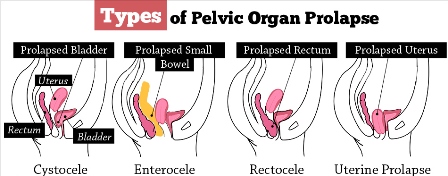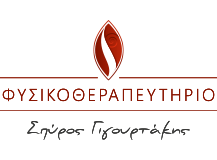Η πρόπτωση πυελικών οργάνων είναι η προεκβολή ενός ή περισσοτέρων πυελικών δομών μέσα στον κόλπο και, σε μερικές περιπτώσεις, έξω από το άνοιγμα του κόλπου. Ο κόλπος περιβάλλεται από ένα σύνολο πυελικών δομών. Το ορθό βρίσκεται κάτω από τον κόλπο, η ουροδόχος κύστη πάνω από αυτόν, και η μήτρα, το έντερο και τα υπόλοιπα κοιλιακά όργανα βρίσκονται πίσω του. Όταν η στήριξη ανάμεσα σε μία από αυτές τις δομές και τον κόλπο εξασθενεί, μπορεί να παρουσιαστεί πρόπτωση.
Αυτό έχει ως συνέπεια την πρόπτωση σε κάποια από τις πυελικές δομές (ορθού, μήτρας και ουροδόχου κύστεως). Στις ομάδες υψηλού κινδύνου με αυξημένη πιθανότητα για χειρουργική αποκατάσταση, ανήκουν άτομα παχύσαρκα, άτομα με έντονη χειρονακτική εργασία (άρση βάρους), γυναίκες κατά την διάρκεια της κύησης ή μετά από φυσιολογικό τοκετό, δηλαδή περιπτώσεις που προκαλείται αυξημένη ενδοκοιλιακή πίεση. Οκτώ στις 100 γυναίκες του Ηνωμένου Βασιλείου αναφέρουν συμπτώματα και η χειρουργική επέμβαση είναι σχετικά συχνή.
Η συντηρητική θεραπεία περιλαμβάνει την ενδυνάμωση των μυών του πυελικού εδάφους και υπάρχουν ενδείξεις ότι μπορεί να μειώσει την σοβαρότητα και τα συμπτώματα της πρόπτωσης. Παρόλα αυτά περαιτέρω έρευνες θα πρέπει να διεξαχθούν, προκειμένου να διαπιστωθεί αν η ενδυνάμωση των μυών του πυελικού εδάφους , μπορεί να αποτρέψει τα συμπτώματα και την πιθανότητα ενός χειρουργείου στο μέλλον.

What did this study do?
This randomised controlled trial, PREVPROL, recruited 412 women from three centres in the UK and New Zealand who had given birth in 1993 to 1994. The women could be any age, with evidence of prolapse, who had not already undergone treatment.
Researchers randomly allocated 206 women to pelvic floor muscle training and 206 women to the control group. The training group were offered five appointments with a physiotherapist, given an individualised training programme and advice, and given a lifestyle advice leaflet. They also had pilates classes and physiotherapy review appointments after one and two years. At two years 77% of women in the treatment group were still doing their pelvic floor exercises. The control group received the lifestyle advice leaflet in the post. The results were measured after two years, comparing symptoms and cost effectiveness.
The results of this large multicentre trial are likely to be reliable, although the participants and physiotherapists knew which group they were in. This could have introduced some bias when reporting symptoms.
What did it find?
- The main outcome was severity of prolapse symptoms at two years, measured using the Pelvic Organ Prolapse Symptom Score (POP-SS). This has a scale of 0 to 28, with 0 meaning no symptoms in the previous four weeks, and 28 meaning all symptoms were present all the time. Average POP-SS reduced from a baseline of 4.4 to 3.2 at two years in those who had pelvic floor muscle training compared to increasing from 3.9 to 4.2 in the control group (mean difference [MD] ‑1.01, 95% confidence interval [CI] ‑1.70 to ‑0.33).
- Using the ICIQ-Urinary Incontinence form (a scale of 0 to 21 which combines frequency of urine leakage, amount and associated bother, with a higher score indicating more problems), the training group average score decreased from 4.8 to 3.3 after two years while it remained the same for the control group, 4.2 to 4.1(MD ‑0.83, 95% CI ‑1.44 to ‑0.22).
- Fewer women in the training group had any further treatment for prolapse symptoms during the two-year follow-up (6%) than those in the control group (14.4%). Odds Ratio 0.29 (95% CI 0.12 to 0.71). In particular, women in the training group were less likely to see their GP: 3% versus 12%.
What does current guidance say on this issue?
NICE is developing a guideline on the management of urinary incontinence and pelvic organ prolapse (due in February 2019). NICE has produced a number of pieces of guidance on surgical techniques to treat different types of prolapse – these all list pelvic floor muscle training as an option for treatment.
What are the implications?
This high quality study suggests that pelvic floor muscle training could be a useful option for managing minor pelvic organ prolapse. It may also reduce the need for further treatment such as surgery. It is a safe option that could be done easily learned by most women and started once prolapse is first recognised and before they symptoms become more troublesome.
The effects seen in this study are small, and as a research study involved a lot of input from specialist physiotherapists. The researcher’s planned long-term follow-up would allow us to see if there would be real cost-savings or if there are simpler ways of delivering the intervention.
Πηγή: Hagen S, Glazener C, McClurg D, et al. Pelvic floor muscle training for secondary prevention of pelvic organ prolapse (PREVPROL): a multicentre randomised controlled trial. Lancet. 2017;389(10067):393-402.

